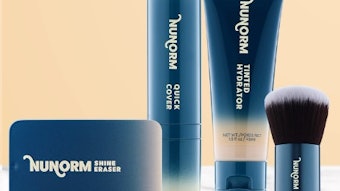Society as a whole does not appreciate age reminders, particularly in the mirror. Women had nearly 10,500,000 cosmetic procedures performed in 2005, accounting for 91.4% of the total number of procedures, to correct signs of aging. Consumers want to look younger and they are willing to pay for it.
Not Just Wrinkles
Wrinkles, while being primarily associated with aging, are just one of several signs of aging that products attempt to reverse or reduce. Skin clarity, darkening pigment and loss of firmness all contribute to the aging process. In addition, age spots, acne and uneven skin tone contribute to the skin’s overall appearance.
Combating acne is a problem for adults as well as teenagers. Antiaging products deliver a variety of ingredients to limit or prevent breakouts while addressing traditional concerns, such as collagen breakdown. MD Skincare uses chelators, an organic complex, to sequester heavy metals, and free radicals to prevent damage and collagen breakdown. Heavy metals can lead to skin conditions such as acne, rosacea, irritation and inflammation.
“Additionally, acne scars can look worse as the skin ages and loses collagen. The depth and the diameter of the scars increase.” said Dennis Gross, MD, creator of MD Skincare. “The anti-inflammatory ingredients, because they decrease deep acne, will allow for better aging.”
Dark circles also contribute to a tired and worn out appearance. As a person ages, the thin skin around the eyes becomes thinner, and the fat that plumps the skin disappears. “Skin thins and you can see the circulatory system,” said Lyn Ross, president and CEO, Institut’ DERMed. Additionally, over time, the circulatory system under the eyes begins to leak, called hemoglobin degradation, causing blue-red pigmentation. Products must target the thinning skin, visible circulation and hemoglobin degradation under the eye to create a lighter effect. Natural high potency-based carriers, in addition to skin thickeners such as vitamin K, can reduce the appearance of dark circles with long term use. Hylexin, by Bremann Research Labs, reduces hemoglobin degradation by-products by optimizing enzymatic activity, causing the red-blue pigmentation of dark circles to fade while strengthening the capillary matrix to help stop the leaking, protecting against further damage.
Today’s products include enzymes to stimulate or boost the effects of active ingredients, while peptides act as a bond, fighting the breakdown of collagen and stimulating its growth. But these formulations now include other ingredients for value-added skin care.
While facial aging is a primary target of antiaging products, it is not the only area of concern. Consumers are looking for products that work to prevent or decrease these apparent signs of aging in other areas of the body. For example, hands show signs of aging due to their thin skin with little fat underneath. Aging reduces this fat even further to showcase the veins and bones, while exposure to the sun contributes age spots and dryness. To combat this, hand creams are including sun block, skin brighteners and moisture barriers to avoid over drying. For example, Bath & Body Works’ Glove Me Tender uses skin brighteners to improve the appearance of sun spots, shea butter to create a protective moisture barrier and antioxidants to scavenge damaging free radicals. An SPF 15 also protects against sun damage that may contribute to premature aging of the skin.
Brighter Skin
Often, the biggest factor of aging is the overall tone of the skin. “As we approach the age of 30, skin becomes duller,” said Nathalie Chevreaux, PhD, R&D, director of Women’s Health at Basic Research, an R&D and product development lab. “And interestingly enough, this change in skin tone and color can occur in all ethnic groups.”
According to Richard Wells, PhD, director of scientific affairs, Bremenn Research Labs, changing skin color has a lot to do with light waves, color frequencies and how light is reflected. “As we age, proteins in the skin’s epidermis become cross-linked and rigid, thus losing transparency and the ability to reflect warmer pink tones. Unlike simple age spot removers, new-generation facial brighteners are designed to be used over the entire face. They make you look younger by increasing skin’s brightness scale and amplifying full-spectrum reflectivity, luminescence and clarity.”
While facial brightening targets overall skin tone, not just age spots, formulators have had to adjust to the ban of hydroquinone, finding different ingredients to achieve similar results. Following the naturals trend, these ingredients now include natural extracts and essential oils, such as kojic acid. All skin brighteners are targeting sun damage, so sunscreen, found in some moisturizers and cosmetics, is still the traditional way to prevent this sign of aging.
Consumers want to look and feel beautiful inside and out. As a result, dietary supplements working in concert with topical methods and products with active ingredients producing changes to the skin are becoming popular, complementing the increased focus on lifestyle as part of the aging process. A recent Datamonitor report predicted the overall European cosmeceuticals market to grow $4.4 billion in 2009, which includes all cosmetic products containing at least one bio-active ingredient for the skin. The same report stated that 63.7% of women over the age of 50 are prepared to spend more on cosmeceuticals.
Follow the Value
According to the latest market report from the Freedonia Group, the demand is likely to trigger an 8.7% annual increase in the market for antiaging products. A series of new and improved products that claim to offer both health maintenance and appearance-enhancing benefits to the baby boomer generation are feeding this demand. This group’s attitudes toward aging are changing rapidly, while directly affecting consumer purchasing habits.
“These individuals, who belong to one of the most affluent generations, are willing and able to pay for products that provide antiaging benefits,” stated the Freedonia Group report. Looking specifically at cosmetic products, the market for antiaging ingredients and chemicals is set to grow exponentially. The report highlights that this value-added category will be worth $4.1 billion by 2009, partially due to the increase of technology-driven and proprietary blends that form an integral part of many products’ antiaging claims. Despite conventional wisdom, which keeps many major advertisers focused on younger consumers, the boomer generation is not set in its ways when it comes to product choices, according to studies by MarketResearch.com, which show boomers are more receptive to advertising than their Gen X and Gen Y counterparts, who tend to reject marketing claims out of hand.
While marketing claims do not necessarily resonate with these younger consumers, antiaging as a preventive measure does. Younger consumers are attempting to avoid aging skin concerns through use of antiaging products. “We have so many younger clients using the formulations to ward off signs of aging,” said Ross.
For these consumers, prevention and maintenance are key components to their attitudes while purchasing antiaging products. This need to prevent instead of cure focuses on products with age-defying elements. For example, Skingenic utilizes antioxidants, such as Idebenone, green tea and lychee fruit, to provide moisture and environmental protection while delivering nutrients that improve the overall complexion. These elements combine to prevent the damage that contributes to the ills commonly attributed to aging skin, thus appealing to the younger consumer.
Warding off the signs of aging includes using value-added products that focus on more than just the fine lines and wrinkles, addressing concerns that contribute to the overall appearance of the skin. Targeting baby boomers means addressing their skin concerns, while addressing long-term maintenance for younger consumers looking to ward off these signs of aging.
With an increasing focus on the benefits of lifestyle changes for overall well-being, aging baby boomers want to see their healthy lifestyle reflected in their skin. As a result, they look for skin care products that delay or reverse the signs of aging skin by providing value added benefits beyond wrinkle reduction. To stay on top of this growing trend, antiaging products must focus on preventing or curing a variety of skin ills, not just the wrinkles and fine lines.










